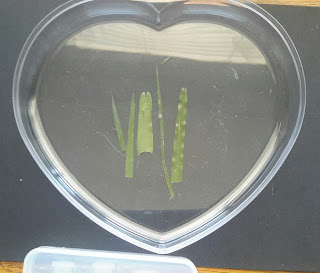There's a similar free or cheap deal on offer for my Playwiths ebook as well, and to see what else I have been doing (LOTS!), go to this link.
(Edit 40/4/2018) Links to previous parts:
Part 1, Part 2, Part 3, Part 4, Part 5
Right now, I am designing activities for young people using the Go Macro, and I have just comprehensively sorted out the focal plane problem. In simple terms, a natural leaf is curved, and that means part of it are out of the shallow focal plane that we are restricted to.
My usual solution is to use a microscope slide, to flatten the leaf out and hold it in the focal plane, but while I have microscope slides to hand, other people may not. Incidentally, the leaf is resisting a bit here, but when I rest the Go Macro lens on it, it flattens down, soon enough.
Once upon a time, things came in little boxes made of cardboard or even wood (like the matchboxes of my youth). Classier things like chocolates came in boxes made of tinplate, and I still carry my specimen tubes in a Barkley Mints tin, which is recent enough to have a barcode on it, or a neat little PVC box that rattles less. That said, the norm, now is transparent polystyrene boxes.
Most of the bits and pieces sitting on my desk are in chocolate boxes of that sort, so the idea of using them jumped into my head:
Notice the box at the bottom: you will see it in use in the next picture:
Maybe you aren't a chocaholic, though, so I cast around for other solutions:
The lid of a CD "crystal case" also works, and so do the polystyrene Petri dishes that I commonly use for the same purpose. Each of these has a small drawback: a small vertical flange, for want of a better term. This stops the base making a firm contact with the table or desk top, bu that is precisely what we want, so the sample lies, flattened, in the focal plane. The answer is simple: slip a microscope slide or a piece of cardboard under the leaf.
Now we are cooking with gas!
Oh, if you want to buy slides or Petri dishes, I have no relationship with these people, but I have had nothing but prompt service from Australian Entomological Supplies. I note that the owner died recently, but it appears that orders are still being processed.
Here are a couple of samples from this morning: I am trying to get good shots of the silica hairs on grass leaves.
Well, I'm still tweaking...







No comments:
Post a Comment